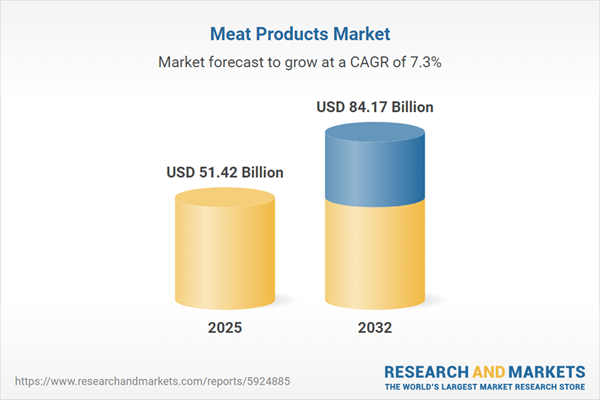Speak directly to the analyst to clarify any post sales queries you may have.
Senior executives in the global meat products market face a rapidly evolving landscape shaped by shifting demand, technological innovation, and regulatory complexity. Maintaining operational resilience and sustainable growth calls for precise, informed strategies tailored to ongoing industry change.
Market Snapshot: Global Meat Products Market Trends
The global meat products market is estimated at USD 47.84 billion in 2024 and is projected to reach USD 51.42 billion by 2025, with further growth to USD 84.17 billion by 2032. This increase is driven by a 7.31% compound annual growth rate (CAGR), underscoring robust capital investment as companies implement advanced processing solutions. Manufacturers are prioritizing supply chain resilience by adopting sophisticated packaging and transparency enhancements to build stakeholder trust. Regional differentiation is accelerating, with executive strategies emphasizing regulatory alignment and operational effectiveness across diverse international markets.
Scope & Segmentation of the Global Meat Products Market
This analysis equips senior stakeholders with granular insight into key market segments, fostering actionable planning for regulatory shifts and technological advancements. Clear segmentation helps decision-makers optimize portfolios and rapidly identify emerging risks, supporting competitive market positioning.
- End Users: Businesses targeting foodservice providers, retail channels, and household buyers must deliver innovation, convenience, and clear value. Adapting to these evolving requirements drives investment and shapes prioritization within product development pipelines.
- Form: Offerings range from fresh, frozen, and processed varieties, such as bacon, sausages, cold cuts, and ham. Robust SKU management ensures alignment with the needs of both retail and hospitality operators, supporting effective market coverage.
- Distribution Channel: Access to supermarkets, hypermarkets, online platforms, convenience stores, and foodservice outlets is essential for consistent branding. Executives must address differing quality expectations and logistical challenges in these diverse channels to maintain customer loyalty.
- Packaging Type: Bulk, tray-pack, and vacuum-sealed options extend shelf life, support compliance with safety and sustainability mandates, and meet the evolving preferences of trade partners and consumers alike.
- Protein Types: Beef, pork, poultry, lamb, and goat are tailored to local tastes and cultural expectations. Curating product portfolios to regional dietary norms is crucial for competitive differentiation.
- Regions: Coverage spans the Americas, Europe, Asia-Pacific, and Middle East & Africa, each presenting distinct consumer behaviors, regulatory contexts, and strategic imperatives. Executives must design geographically adaptive business plans for effective local market entry.
- Technologies: Enterprises leverage automation, robotics, digital traceability solutions, and advanced packaging to streamline operations, bolster transparency, and improve supply chain sustainability across each segment.
- Leading Companies Assessed: The report benchmarks companies including JBS S.A., Tyson Foods, Cargill, WH Group, Marfrig, BRF S.A., Danish Crown, Hormel Foods, NH Foods, and Vion Food Group for responsiveness and innovative capabilities in global market models.
Key Takeaways: Strategic Insights for Senior Decision-Makers
- Automation and robust traceability promote a transparent operating environment, empowering agile adaptation to changing market needs and regulations.
- Sustainable sourcing and renewable energy investments are reshaping compliance approaches and enhancing long-term business resilience for leading market participants.
- Broader, diversified supplier and distribution networks decrease reliance on single sources, reducing exposure to supply disruption while ensuring procurement consistency.
- Enhanced portfolio segmentation and customer-driven initiatives allow organizations to compete across mainstream and premium product segments, supporting higher differentiation.
- Expansion of partnerships and collaborative development is fast-tracking the introduction of clean-label and wellness-focused offerings, meeting shifting consumer preferences.
Tariff Impact on Market Dynamics
Recent U.S. tariff adjustments have compelled industry players to realign supplier strategies and recalibrate pricing models. By reinforcing sourcing flexibility, updating contract frameworks, and strengthening supply chain controls, companies are better positioned to mitigate trade volatility and uphold product standards.
Methodology & Data Sources
Insights are drawn from executive interviews, supplier engagements, and regulatory reviews. Proprietary datasets are rigorously validated by industry specialists to ensure findings are actionable and relevant for senior decision-makers.
Why This Report Matters
- Enables executive teams to remain agile in the face of regulatory, technological, or consumer-driven shifts by providing robust, actionable intelligence.
- Supports resilient supply chain and continuity planning, enhancing an organization's ability to preserve market position in fluctuating environments.
- Delivers reliable, data-driven perspectives for evaluating opportunities in mature and growth regions alike, supporting informed decision-making on expansion or investment strategies.
Conclusion
Leveraging insights from this analysis enables executives to drive strategic transformation, strengthen supply chain integrity, and sustain organizational leadership in a dynamic global sector.
Additional Product Information:
- Purchase of this report includes 1 year online access with quarterly updates.
- This report can be updated on request. Please contact our Customer Experience team using the Ask a Question widget on our website.
Table of Contents
3. Executive Summary
4. Market Overview
7. Cumulative Impact of Artificial Intelligence 2025
Companies Mentioned
The companies profiled in this Meat Products market report include:- JBS S.A.
- Tyson Foods, Inc.
- Cargill, Incorporated
- WH Group Ltd.
- Marfrig Global Foods S.A.
- BRF S.A.
- Danish Crown A.m.b.a.
- Hormel Foods Corporation
- NH Foods Ltd.
- Vion Food Group N.V.
Table Information
| Report Attribute | Details |
|---|---|
| No. of Pages | 181 |
| Published | October 2025 |
| Forecast Period | 2025 - 2032 |
| Estimated Market Value ( USD | $ 51.42 Billion |
| Forecasted Market Value ( USD | $ 84.17 Billion |
| Compound Annual Growth Rate | 7.3% |
| Regions Covered | Global |
| No. of Companies Mentioned | 11 |









